Bodhi Priyantha
Long-Range Backscatter Connectivity via Spaceborne Synthetic Aperture Radar
Feb 15, 2024Abstract:SarComms is a new communication method that enables passive satellite backscatter connectivity using existing spaceborne synthetic aperture radar (SAR) signals. We demonstrate that SAR signals from the European Space Agency's Sentinel-1 satellite, used for imaging the Earth, can also be leveraged to enable ground-to-satellite connectivity. This paper presents the first cooperative, on-the-ground target that modulates SAR backscatter to send information bits and analyzes how to extract it from publicly available Sentinel-1 datasets. To demonstrate the system's feasibility, we evaluate the effectiveness of corner reflectors in the field, develop a deployment algorithm to optimize reflector placement and prototype modulating corner reflectors (both mechanically and electrically controlled) to change the amplitude of backscattered SAR signals.
Single-Path Mobile AutoML: Efficient ConvNet Design and NAS Hyperparameter Optimization
Jul 01, 2019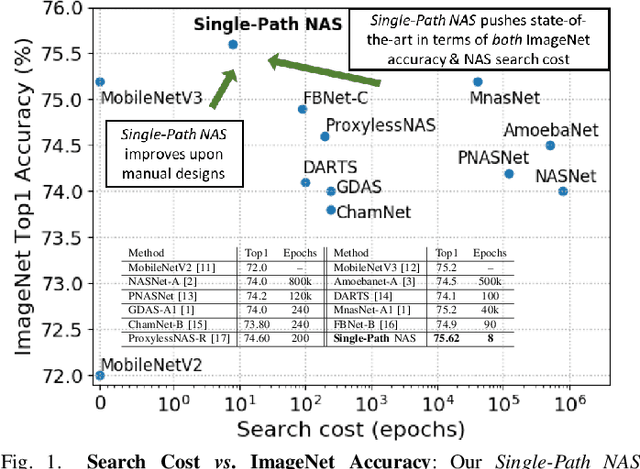
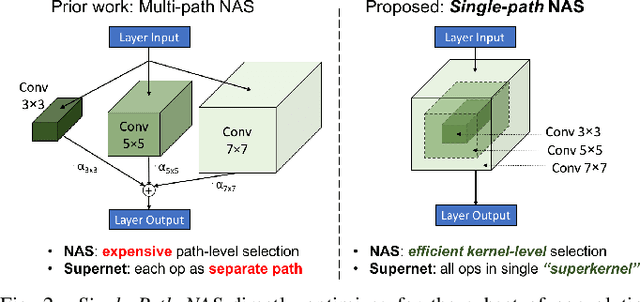
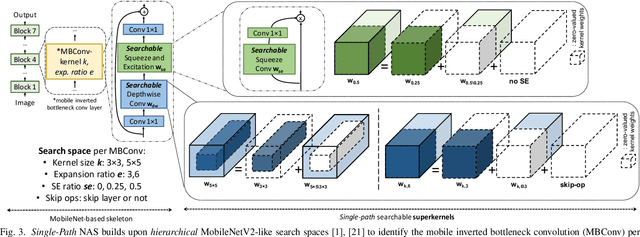

Abstract:Can we reduce the search cost of Neural Architecture Search (NAS) from days down to only few hours? NAS methods automate the design of Convolutional Networks (ConvNets) under hardware constraints and they have emerged as key components of AutoML frameworks. However, the NAS problem remains challenging due to the combinatorially large design space and the significant search time (at least 200 GPU-hours). In this work, we alleviate the NAS search cost down to less than 3 hours, while achieving state-of-the-art image classification results under mobile latency constraints. We propose a novel differentiable NAS formulation, namely Single-Path NAS, that uses one single-path over-parameterized ConvNet to encode all architectural decisions based on shared convolutional kernel parameters, hence drastically decreasing the search overhead. Single-Path NAS achieves state-of-the-art top-1 ImageNet accuracy (75.62%), hence outperforming existing mobile NAS methods in similar latency settings (~80ms). In particular, we enhance the accuracy-runtime trade-off in differentiable NAS by treating the Squeeze-and-Excitation path as a fully searchable operation with our novel single-path encoding. Our method has an overall cost of only 8 epochs (24 TPU-hours), which is up to 5,000x faster compared to prior work. Moreover, we study how different NAS formulation choices affect the performance of the designed ConvNets. Furthermore, we exploit the efficiency of our method to answer an interesting question: instead of empirically tuning the hyperparameters of the NAS solver (as in prior work), can we automatically find the hyperparameter values that yield the desired accuracy-runtime trade-off? We open-source our entire codebase at: https://github.com/dstamoulis/single-path-nas.
Single-Path NAS: Device-Aware Efficient ConvNet Design
May 10, 2019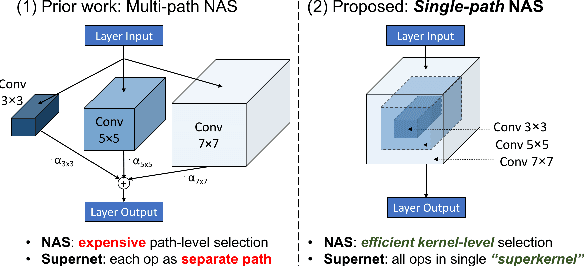


Abstract:Can we automatically design a Convolutional Network (ConvNet) with the highest image classification accuracy under the latency constraint of a mobile device? Neural Architecture Search (NAS) for ConvNet design is a challenging problem due to the combinatorially large design space and search time (at least 200 GPU-hours). To alleviate this complexity, we propose Single-Path NAS, a novel differentiable NAS method for designing device-efficient ConvNets in less than 4 hours. 1. Novel NAS formulation: our method introduces a single-path, over-parameterized ConvNet to encode all architectural decisions with shared convolutional kernel parameters. 2. NAS efficiency: Our method decreases the NAS search cost down to 8 epochs (30 TPU-hours), i.e., up to 5,000x faster compared to prior work. 3. On-device image classification: Single-Path NAS achieves 74.96% top-1 accuracy on ImageNet with 79ms inference latency on a Pixel 1 phone, which is state-of-the-art accuracy compared to NAS methods with similar latency (<80ms).
Single-Path NAS: Designing Hardware-Efficient ConvNets in less than 4 Hours
Apr 05, 2019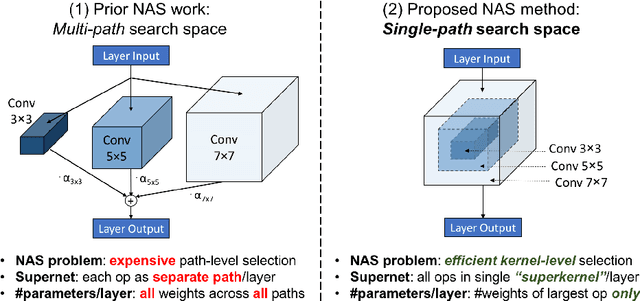
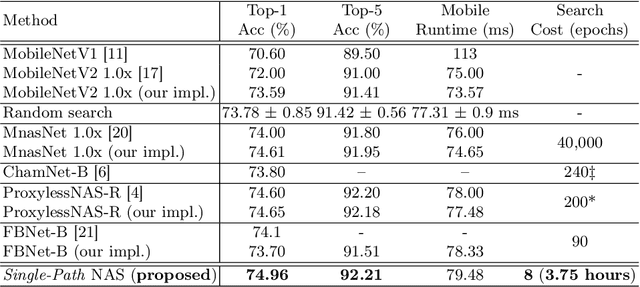
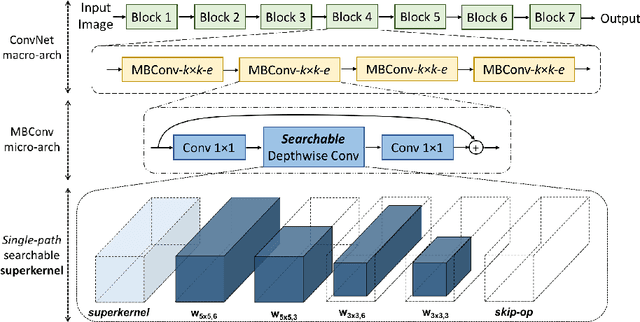

Abstract:Can we automatically design a Convolutional Network (ConvNet) with the highest image classification accuracy under the runtime constraint of a mobile device? Neural architecture search (NAS) has revolutionized the design of hardware-efficient ConvNets by automating this process. However, the NAS problem remains challenging due to the combinatorially large design space, causing a significant searching time (at least 200 GPU-hours). To alleviate this complexity, we propose Single-Path NAS, a novel differentiable NAS method for designing hardware-efficient ConvNets in less than 4 hours. Our contributions are as follows: 1. Single-path search space: Compared to previous differentiable NAS methods, Single-Path NAS uses one single-path over-parameterized ConvNet to encode all architectural decisions with shared convolutional kernel parameters, hence drastically decreasing the number of trainable parameters and the search cost down to few epochs. 2. Hardware-efficient ImageNet classification: Single-Path NAS achieves 74.96% top-1 accuracy on ImageNet with 79ms latency on a Pixel 1 phone, which is state-of-the-art accuracy compared to NAS methods with similar constraints (<80ms). 3. NAS efficiency: Single-Path NAS search cost is only 8 epochs (30 TPU-hours), which is up to 5,000x faster compared to prior work. 4. Reproducibility: Unlike all recent mobile-efficient NAS methods which only release pretrained models, we open-source our entire codebase at: https://github.com/dstamoulis/single-path-nas.
 Add to Chrome
Add to Chrome Add to Firefox
Add to Firefox Add to Edge
Add to Edge